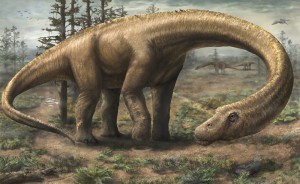Early on the morning of Sept. 5, Drexel held a grand ceremony to reveal the skeleton of Dreadnoughtus schrani, a new kind of titanosaur, in the Papadakis Integrated Science Building. The discovery is groundbreaking, as it is the largest known dinosaur of calculable weight to have been unearthed yet.
The skeleton was exhumed by associate professor Kenneth Lacovara and his team of graduate and undergraduate students. Though the excavation took place in Patagonia, Argentina, and spanned a four-year period from 2005 to 2009, the skeleton only recently made its way to the United States to undergo a large array of research and studies.
The ceremony began with a great assembly of Drexel administrators as well as local Philadelphia press gathering into the main entrance of Papadakis. After a brief introduction announcing the man of the hour, Lacovara walked up to the podium to unveil his major find. He began by thanking the diverse team that helped him excavate the titanic skeleton: a small group of graduate students and almost 75 undergraduates that assisted the project in some way or another.
Then he thanked the co-authors of his paper in which his findings were published and finally the sponsor who supported the project, entrepreneur Adam Schran. Schran was honored by having the dinosaur named after him, with the species being christened “schrani.” Additionally, many members of the Drexel administration — such as former vice provost Mark Greenberg — were thanked for their work in negotiating with Argentina in order for the bones to be removed from the country. Because the Argentine state owns any fossils discovered within its borders, this process had to be delicately handled and required much coaxing of Argentine officials.
After all the pleasantries were through, Lacovara revealed the tibia (shinbone) of the creature, which was carbon-dated to over 77 million years ago. By piecing together the skeletal structure of the beast, the research team determined that it was approximately 85 feet long and over two stories tall.
To give the audience some context, the outline of the dinosaur was traced onto the floor of Papadakis, much to the amazement of everyone gathered round. Lacovara then went on to explain that the largest land mammal today, the two-ton African elephant, is dwarfed by this titan which weighed over 65 tons.
“Just hearing about something so drastically different from anything we ever knew or could imagine makes it feel like a monumental point in history,” sophomore finance major Mickey Kaiser said. “We grow up learning about dinosaurs as kids and they fascinate us. It’s very cool to be actually able to learn about them again to this day as an adult.”
Besides discovering a whole new species, other facts that became apparent marked the discovery as unique as well. The area that the dinosaur was excavated from was found to have been flooded millions of years ago. It is speculated that the Dreadnoughtus was caught in the same flood. At the time, it was not even fully grown but was still clearly the largest organism of its time. The whole excavation took almost four years and while the bones were delivered to the United States in 2009, it took almost three years to fully clean and prepare the fossils for study.
Many students, faculty, and members of the public were present for the ceremony despite it being so late in the term. The finding has been covered by numerous news sources; The Guardian, BBC, and many others.
“Coming to an unveiling of a new dinosaur was pretty exciting, the huge crowd and so many people made it more so,” Robyn Smith, a fourth-year physics major, said. “It has very little to do with my major but I still came to see it even while on co-op. It doesn’t have to pertain to your field to appreciate how big a discovery it is, just like any other advancement of science.”
While there was only one bone available to be viewed on the main floor, Lacovara has over 145 bones of the dinosaur in his lab, Lab 504, located on the upper floors of the building. After his speech, the press and the general public were allowed to go into the labs upstairs and view the full collection of bones for the duration of the day.
Lacovara, his team, and the Academy of Natural Sciences are currently studying the bones as per the research agreement with Argentina until 2015, whereupon they will be shipped back for permanent residence in the Museo Padre Molina in Rio Gallegos.
3-D images of the bones are available in a supplement to Lacovara’s paper in the journal “Scientific Reports,” titled “A Gigantic, Exceptionally Complete Titanosaurian Sauropod Dinosaur from Southern Patagonia, Argentina,”.



